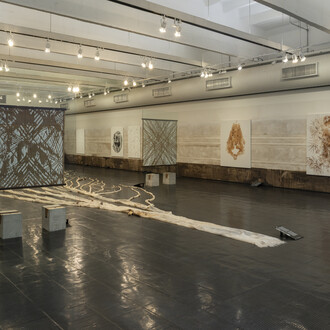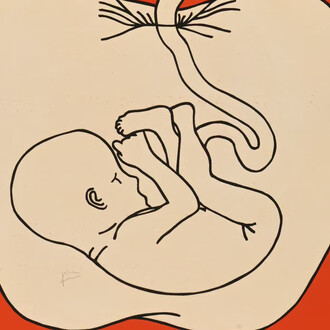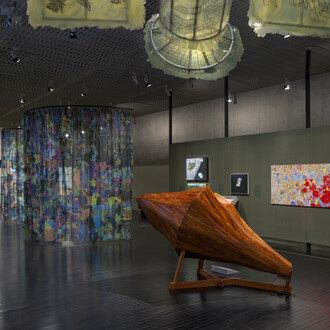The exhibition Otros cuentos inconclusos [Other unfinished tales] features over 30 works by Argentine artist Liliana Porter, offering an overview of her output from the past five years. Based in New York since 1964, Porter has built a career spanning 60 years, during which she has developed a solid and meaningful investigation into how to represent the human condition. This is Porter’s fifth exhibition at Luciana Brito Galeria, which also held her first solo show in Brazil in 2001.
Otros cuentos inconclusos takes its title from her most recent audiovisual work, created in collaboration with artist Ana Tiscornia. True to its name, the video presents brief narratives whose endings are left to the viewer’s imagination. The video is structured in five segments, weaving together narratives that combine phrases from the children’s literature classic Sinbad, the sailor with animated scenes from the artist’s installations. The soundtrack, by Sylvia Meyer, plays a crucial role, not only setting the mood for each scene but also breathing life into the inanimate characters.
Porter’s artworks present miniature visual fables – timeless chronicles of our own human condition. She has mastered the skill of creating highly distilled representations, which, paradoxically (or perhaps ironically), emerge from her practice of collecting. Nicknacks, toys, ornaments, and other small discovered objects come to life in her hands. They remain in storage until they are “licensed” by her poetics – sometimes acerbic, sometimes humorous.
Through combinations of these elements – often enhanced with paintings and drawings – she treats on profound questions inherent to contemporary society. A good example is The anarchist (woman in red) (2022), where a tiny figure is engaged in an enormous task: unraveling an entire ball of wool to create obstacles for anyone wishing to enter the space. Another is The way out (with red car) (2022), where a massive barrier is powerless to stop a simple red car. The exhibition includes a group of 20 small assemblages on paper as well as ten micro-installations, where miniature objects acquire great narrative power through metaphors involving time, embodying memories drawn from the deepest corners of shared human experience-
![Liliana Porter, Otros cuentos inconclusos [Other unfinished tales], exhibition view. Courtesy of Luciana Brito Gallery](http://media.meer.com/attachments/98ae16e7e39e3cc8839e3dd8e26574e8d2f0f635/store/fill/1090/613/c58fb9c82156e4df14f9ee9cb40200c43b3eb10dc5d9ebbcfd6b6c30dc29/Liliana-Porter-Otros-cuentos-inconclusos-Other-unfinished-tales-exhibition-view-Courtesy-of.jpg)

![Liliana Porter, Otros cuentos inconclusos [Other unfinished tales], exhibition view. Courtesy of Luciana Brito Gallery](http://media.meer.com/attachments/c52620e2b29b160a479dc0f77b192706ebca7d16/store/fill/410/308/2e92fee884ae9dc19a5f820f890338df19dc4320eb70ab0b3fbd37036ac6/Liliana-Porter-Otros-cuentos-inconclusos-Other-unfinished-tales-exhibition-view-Courtesy-of.jpg)
![Liliana Porter, Otros cuentos inconclusos [Other unfinished tales], exhibition view. Courtesy of Luciana Brito Gallery](http://media.meer.com/attachments/d54b35320a51ef1a71bf7f37e8aed5a7c3791449/store/fill/410/308/a688676629a7f0295148fdf8632b2d365321a2efb4c824adab1eacf478bf/Liliana-Porter-Otros-cuentos-inconclusos-Other-unfinished-tales-exhibition-view-Courtesy-of.jpg)
![Liliana Porter, Otros cuentos inconclusos [Other unfinished tales], exhibition view. Courtesy of Luciana Brito Gallery](http://media.meer.com/attachments/77aa42ba0d189701a3de75af26c83f1780dc14f6/store/fill/410/308/41e12d56227deb045ef16d22f86f68d675462832f12c1837131f4b383f0d/Liliana-Porter-Otros-cuentos-inconclusos-Other-unfinished-tales-exhibition-view-Courtesy-of.jpg)








